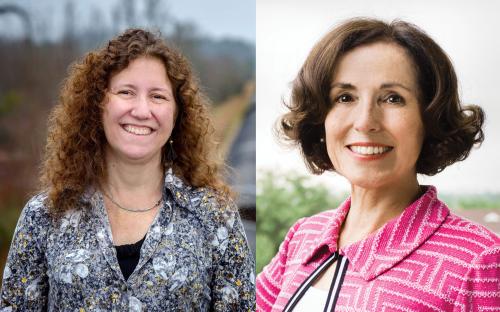
Gabriela Gonzalez, former assistant professor of physics at Penn State (1998-2001) and current LIGO scientist and professor of physics at Louisiana State University, had been working with LIGO since 1997. In 2011, she was elected the spokesperson for the LIGO Scientific Collaboration. At the press conference for the announcement of LIGO’s detection of gravitational waves, Gonzalez was one of the five people on the stage to talk about the discovery. The other person on that stage with Penn State connections was France Cordova, the director of the National Science Foundation (NSF) and former head of Penn State’s Department of Astronomy and Astrophysics (1989-1993).
“Without a doubt the reason so many of us are here today is that we believe in the potential of the Laser Interferometer Gravitational-Wave Observatory,” said Cordova in her opening speech at the LIGO press conference.
The NSF in particular has believed in the potential of LIGO and has funded the project for decades. Many were skeptical when the NSF decided to spend $300 million to build the original LIGO observatories proposed in a scientific paper in 1972. It was a big risk for an agency that had only until then funded small-scale research projects.
“In 1992, when the National Science Board approved LIGO’s initial funding, it was the largest investment NSF had ever made,” said Cordova. “It was a big risk. But the National Science Foundation is the agency that takes these kinds of risks. NSF funds trailblazers.”
Cordova, with her background in physics, astronomy, and astrophysics, has been a staunch supporter of the project since she began as director of the NSF in 2014.
“LIGO is a groundbreaking discovery which demonstrates the vital importance of the mission of the NSF. Because of the NSF, we have opened a new observational window that will allow the world to see our universe in an entirely new way. It’s the start of a whole new way of looking at and learning about our cosmos,” she said.
Gonzalez came to the podium at the press conference to explain the science behind the discovery. She explained that the gravitational-wave signal was first detected at the LIGO Livingston facility, and the same reading detected at the LIGO Hanford facility a mere seven seconds later, even though the facilities are 1,865 miles apart.
The actual reading ended up being “a tiny fraction of a proton in diameter,” according to Gonzalez. “You can see that these signals have oscillations that grow in frequency and amplitude and then settle down, and that’s exactly the prediction that we know from solving Einstein’s equations on computers for the coalescence of black holes merging into a larger black hole and settling down.”
The LIGO team calculated a numerical relativity simulation for the event of two black holes merging, and the data lined up eerily with the gravitational wave detections at both LIGO facilities. The waveform gave the team much data and information about the event, including the distance away the black hole merger was.
“It was more than a billion light years away,” Gonzalez explained. “This merger happened 1.3 billion light years away when multicellular life here on Earth was just beginning to spread. The signal took a billion years to come to Earth and produce this tiny distortion in our detectors.”
